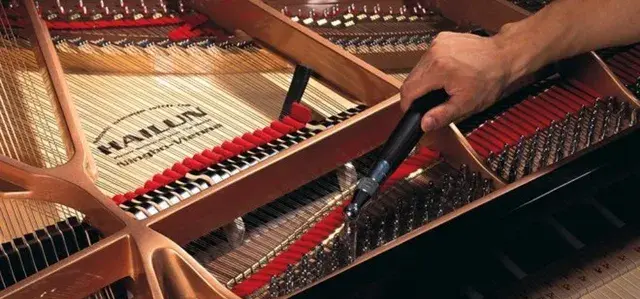How to Tune a Piano: A Simple Guide

Why learn how to tune a piano?
We are all looking for ways to save a little money. Tuning your own piano could save you anywhere from a couple of hundred dollars (if you tune once or twice per year) to much more.
If you just plain love all things piano, learning to tune your piano is also a terrific way to get to know your instrument and also exponentially increase your knowledge, hands-on.

There is something incredibly satisfying about learning to maintain your own instrument.
You could even turn a satisfying hobby into a side business or a career as a piano tuner!
Piano tuners are needed everywhere, even in small towns -- above and beyond tuning pianos in private homes, churches, schools, and senior centers usually have pianos that need regular tunings.
If you love people and love pianos, you could be a natural!
How to Tune a Piano - Learn from a Professional
Many professional piano technicians advise against amateurs tuning their own pianos.
Why?
Well, even though the mechanics of piano tuning are simple, tuning is actually delicate work and can take years to master. Over-tightening can break strings; aggressive turning can loosen pins. Simply put, you could cause expensive damage to your piano.
However, a little common sense goes a long way. You can learn to tune your own piano, but I wouldn’t learn on a Steinway -- leave that to the professionals!
And please don’t learn to tune on a piano that’s been in your great-aunt’s basement for the last 30 years. Chances are, a piano like that will need at least a pitch-raise, and most likely repair, before it can be tuned properly. Leave that to the pros as well.
If you have a more modest piano, are not in a hurry, and have just a bit of patience, you won’t have any problems learning how to tune a piano.
You can get started right away, and learn from a professional piano technician. Tuner Technicians Forum has excellent, inexpensive advice that will teach you, step by step, how to tune your own piano.
How to Tune Your Own Piano will take you step-by-step through the tuning procedure, help you learn to listen and use the correct tools, and give you the kind of tips only a master tuner of 35+ years knows!
Here's what you'll learn
· Learning to Hear Beats: Learn what to listen for as you tune a piano.
· The Tuning Hammer: positioning and using the tuning hammer.
· Tuning Exercises: train your ear to detect when notes are in tune.
· Setting the Temperament: this is the most important part of the piano tuning procedure.
· Tuning the Bass: techniques that make this part of the tuning easy and satisfying.
· Tuning the Treble: The treble has its own unique tuning techniques.
· Tuning the Unisons: each note on a piano has three strings per note in the treble section. These three strings must all be at the same pitch for the note to sound in tune.
· Tuning Problems: some pianos are more difficult to tune than others. Learn to overcome these difficulties with ease.
A very good, basic set of instructions on learning to tune a piano can be found at piano.detwiler.us.

Piano.detwiler.us gives you all the necessary information to get started tuning.
If you don’t know what equal temperament is, you could definitely learn more about how pianos are tuned and why pianos were tuned differently during different times in history!
Use this free resource to learn about the process, the tools you’ll need, and to be encouraged that you can indeed learn how to tune a piano.
It’s a great starting point. But I heartily recommend the Piano Tuning Video -- you have a master teacher guiding you through the learning process!
What tools are needed to tune a piano?
A good piano tuner will have a tuning lever, which is a wrench-like tool used for turning the tuning pins; a string cutter, which is used to remove some of the string's length; a mutes tool, which is used to dampen the strings; a tuning fork, which is used to tune the first note (generally A4) of the piano and an electronic tuning device.
The tuning lever is the most important tool.
There are two types of levers available: Traditional tuning levers and demagnetized tuning levers. Piano tuners are divided into two camps: those who use the traditional tuning lever and those who use the demagnetized tuning lever.
A piano tuner who has been trained to use the traditional tuning lever will always insist that it is the best tool for the job. They will argue that it is easier to get the pins to move than with the demagnetized tuning lever.
A piano tuner who has been trained to use the demagnetized tuning lever will always insist that it is the best tool for the job. They will argue that the traditional tuning lever is more likely to break the tuning pins.
There is no right or wrong answer. It is simply a matter of the piano tuner's education and experience.
The string cutter is a small device that looks like a pair of pliers. It is used to cut the strings to a shorter length. A piano tuner will usually cut the strings to a length of about half of the string's length. The string cutter is a very useful tool. It makes it much easier for the piano tuner to tune the piano.
The mutes tool is used to dampen the strings.
The mutes tool is a small piece of plastic that fits over the strings. It is used to dampen the ringing of the strings. The mutes tool is a very useful tool. It makes it much easier for the piano tuner to tune the piano.
A tuning fork is a small two-pronged metal fork with the tines tuned to vibrate at a specific tone.
It is used to tune musical instruments, notably pianos and other stringed instruments.
Tuning forks were invented in 1711. It's been around since the 18th century.
The important thing to know is that they're not used exclusively for the piano. They are used for tuning most stringed instruments.
An electronic tuning device is a device used to tune musical instruments. It is widely used to tune a piano.
The piano's tuning pins are turned with the tuning lever so that the string is tight, and then the pitch of the string is adjusted to the correct frequency by turning the tuning pin.
The electronic tuning device consists of a pick, a pair of electronic ears, a speaker, and a computer.
The pick is to pick up the sound of the piano string, and the pair of electronic ears and the speaker are connected to the computer through the data line. After the computer receives the sound of the piano string, it will judge whether it is in the standard position. If it is not in the standard position, the speaker will send out a sound of the corresponding frequency.
The piano tuning pin is adjusted by the tuning lever according to the sound frequency until the piano string is in the standard position.
How to Tune a Piano without Tools
The piano is an extremely sensitive instrument. Anything from the weather to the humidity can make the strings stretch and the piano go out of tune.
There are a few ways to tune a piano without tools, but you must have some basic knowledge about how a piano works.
The tuning pins on a piano are usually made of steel. The pins are tightened or loosened with a tuning wrench, which most musicians use, although it is possible to tune a piano without a tuning wrench. A piano has about 250 strings, and each string has a tuning pin. The strings are wound around them.
If you want to tune a piano without tools, you need a tuning lever.
A tuning lever is a metal rod with a handle on one end and a hook on the other. The hook is inserted into the tuning pin and turned to tighten or loosen the string.
A tuning lever is a very simple tool that can be found at any music store. If you don't have one, you can buy one for about $10 or rent one for a day for about $5.
To tighten the string, turn the tuning pin counterclockwise with the tuning lever. To loosen it, turn the tuning pin clockwise. If the string is too tight, it can break. If it is too loose, it won't make any sound.
Here's a simple video on how to tune your piano without tools:
Tune a Piano Without Tools




Comments ()